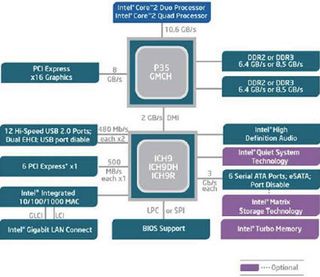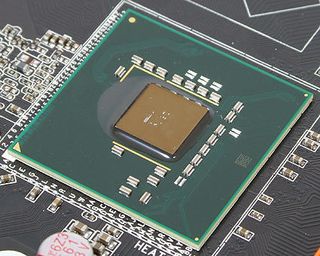Intel Intros 3-Series Chipsets with FSB1333 and DDR3
The 3-Series Chipset Family A.k.a. Bearlake

The new chipset family will consist of at least four devices: G33, G35, P35 and X38. The G33 and P35 chipsets debut June 5; the other versions will follow in early fall. All chipsets again utilize Intel's Land Grid Array socket with 775 connectors (LGA775). So, they could technically work with all existing socket 775 processors - Pentium 4, Celeron, Celeron D, Pentium D and Core 2 Duo/Quad. Although we heard that Intel cancelled support for NetBurst processors, which means that pre-Core 2 processors will not work on most 3-series motherboard, it should be possible to operate a Pentium 4 on some of the 3-series boards. Here is the official statement:
"Intel is not validating any 3 Series chipset outside of an Intel Core Microarchitecture based CPU. If an ODM enables it and is supporting it, it is outside of any Intel warranty and quality."
Make sure you check the manufacturer's Website before purchasing a 3-series product to replace an older P4 motherboard.
G33 and G35 feature GMA X3100 and X3500 integrated graphics, which are DirectX 10 compliant, but may not perform well enough to satisfy anyone with serious gaming or 3D ambitions. As was the case when Intel launched its chipsets in the past, the latest integrated graphics controllers usually provide all necessary features to process video and display more or less beautiful 3D graphics, but they lack performance when compared to discrete graphics cards. At least, the G33 and G35 chipsets offer features to support HD video playback from HD DVD or Blue-Ray discs - Intel summarizes these features as Clear Video Technology. P35 is the mainstream chipset, designed for single-graphics operation. There will also be a Q35, the graphics engine of which is comparable to G33, and was designed for business applications (with the vPro support option). X38, the enthusiast chipset, will benefit from DDR3-1333 memory (which will not be available when Intel launches the P35 and G33), and it will be the first socket 775 chipset to support PCI Express 2.0 (we will have more to say about DR3 memory later on in this article). PCI Express uses the same connectors and is compatible with PCI Express 1, but it doubles the bandwidth per lane (500 MB/s instead of 250 MB/s).
All new 3-series chipsets introduce 90-nm manufacturing into the chipset arena for the first time. The process not only helps to reduce power consumption, it's absolutely imperative to design passively cooled PCI Express 2.0 chipsets due to power requirements that increase with the PCI Express lane count. The P35 has a total of 45-million transistors (which is more than the 42-million transistors of the first Pentium 4 Willamette) and it is rated at a Thermal Design Power of 14.5W (TDP) (the P965 and 975X require up to 19 W). Expect the X38 chipset to be rated somewhere close to 20 W as well. And expect it to be greatly overclockable, as Intel already said that it will remove many over speed protections.
Even if you don't care much for FSB1333 and DDR3 support (it has little performance impact at this point) you might still be interested in the new Southbridge ICH9. While the ICH6, ICH7 and ICH8 Southbridges came in a 652-ball BGA package, the ICH9 is housed in a 676-ball Ball Grid Array, with 4.6-million transistors and 130-nm manufacturing. Although it carries more transistors than the ICH8, it still is rated at 4 W Thermal Design Power. ICH9 offers six fully-featured Serial ATA/300 ports, with NCQ support (Native Command Queuing), and with support for eSATA and port multipliers, so you can attach up to four drives to a single SATA port. We found that both the USB 2.0 performance as well as the RAID performance of ICH9 is superior to ICH8 and ICH7 - more on that in the benchmark section.

Stay on the Cutting Edge
Join the experts who read Tom's Hardware for the inside track on enthusiast PC tech news — and have for over 25 years. We'll send breaking news and in-depth reviews of CPUs, GPUs, AI, maker hardware and more straight to your inbox.
Current page: The 3-Series Chipset Family A.k.a. Bearlake
Prev Page Intel Chipset History Next Page VRM 11 Required For 45-nm ProcessorsMost Popular

